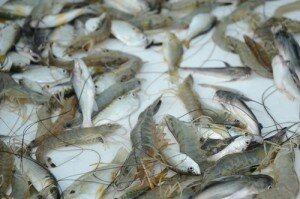NOAA Reopens More than 4,000 Square Miles of Closed Gulf Fishing Area
From Deepwater Horizon Response External Affairs Office:

SHELL ISLAND BAY - Coast Guard Rear Adm. Paul Zukunft, federal on-scene coordinator for the BP oil spill response, looks at shrimp on a sorting table while checking them for signs of oil aboard a 41-foot shrimp boat, August 14, 2010. Federal authorities continue to rigorously test and monitor seafood caught in Gulf waters. U.S. Coast Guard photo by Petty Officer 1st Class Mike Lutz.
NOAA has reopened 4,281 square miles of Gulf waters off western Louisiana to commercial and recreational fishing. The reopening was announced after consultation with FDA and under a re-opening protocol agreed to by NOAA, the FDA, and the Gulf states.
On July 18, NOAA data showed no oil in the area. Light sheen was observed on July 29, but none since. Trajectory models show the area is at a low risk for future exposure to oil, and fish caught in the area and tested by NOAA experts have shown no signs of contamination.
“Scientists, food safety experts, members of the fishing industry and local, state, federal officials, are working together every day to ensure that seafood from the Gulf is safe to eat,” said Jane Lubchenco, Ph.D., under secretary of commerce for oceans and atmosphere and NOAA administrator. “We will remain vigilant and continue to monitor and test seafood in reopened waters.”
Between July 26 and July 29, NOAA sampled the area for both shrimp and finfish, including mackerel and snapper. Sensory analyses of 41 samples and chemical analyses of 125 specimens that were composited into 14 samples followed the methodology and procedures in the re-opening protocol, with sensory analysis finding no detectable oil or dispersant odors or flavors, and results of chemical analysis well below the levels of concern.
At its closest point, the area to be reopened is about 185 miles west of the Deepwater/BP wellhead. The entire area is heavily fished by fishermen targeting reef fish, menhaden and shrimp.
“Because of our strict adherence to the reopening protocol agreed to by the states and the federal government we have confidence that seafood harvested from this area is free from harmful oil residues and can be enjoyed by consumers around the nation,” said Margaret Hamburg, M.D., Commissioner of the Food and Drug Administration.
NOAA will continue to take samples for testing from the newly re-opened area, and the agency has also implemented dockside sampling to test fish caught throughout the Gulf by commercial fishermen. To view the fact sheet released today on the administration-wide effort to ensure Gulf seafood safety, click here.
Fishing closures remain the first line of defense to prevent contaminated seafood from entering the marketplace. NOAA continues to work closely with the U.S. Food and Drug Administration and the Gulf states to ensure seafood safety. NOAA and FDA are working together on broad-scale seafood sampling that includes sampling seafood from inside and outside the closure area, as well as dockside and market-based sampling.
The closed area now covers 48,114 square miles, or about 20 percent of the federal waters in the Gulf, which was 37 percent at its height. On July 22, NOAA reopened 26,388 square miles of Gulf waters off of the Florida Peninsula, and on August 10 opened 5,144 square miles off the Florida Panhandle.
NOAA will continue to evaluate the need for fisheries closures and will re-open closed areas as appropriate.
NOAA has a number of methods for the public to obtain information or be notified when there is a change to the closed area:
- Sign up to receive Southeast Fishery Bulletins by email at .
- Call 1-800-627-NOAA (1-800-627-6622) to hear a recording of the current coordinates in English, Vietnamese, and Spanish.
- Listen to NOAA Weather Radio for messages about the closure.
- Receive text messages on your cell phone about changes to the closed area by texting fishing@gulf to 84469 (visit http://www.deepwaterhorizonresponse.com/go/doc/2931/558107 for more information).
- Follow us on Twitter: @usnoaagov to get a tweet when the closed area changes.
NOAA’s mission is to understand and predict changes in the Earth’s environment, from the depths of the ocean to the surface of the sun, and to conserve and manage our coastal and marine resources. Visit us at www.noaa.gov or on Facebook at .
No related posts.
Short URL: https://browardnetonline.com/?p=9438



